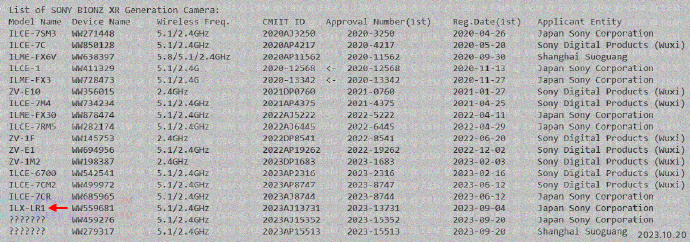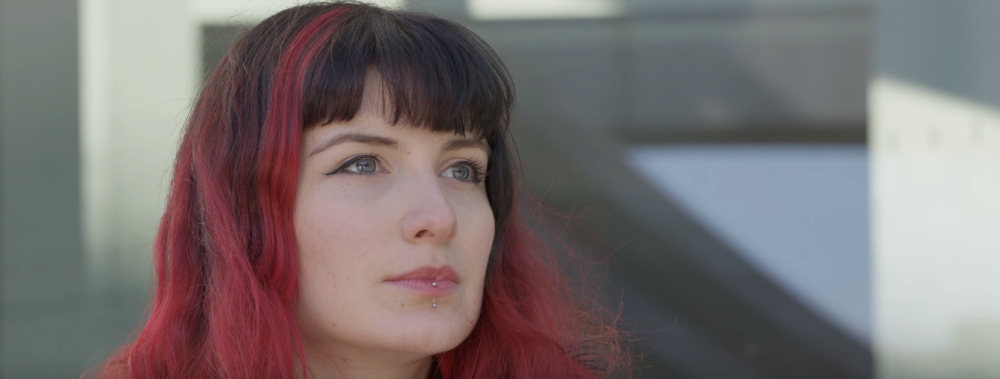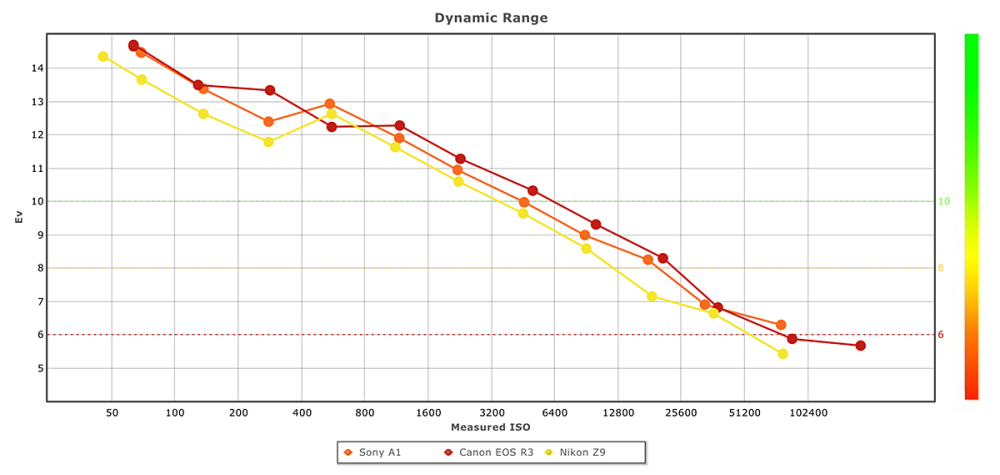
Kino
Members-
Posts
256 -
Joined
-
Last visited
Content Type
Profiles
Forums
Articles
Everything posted by Kino
-
The Venice 6K is a certified Hollywood A-cam and I don't think it should be compared with the Burano, as the latter only offers X-OCN LT. That is a significant downgrade from the RAW and X-OCN options on the Venice cameras. My hope is that if they do bring out a Burano 6K, it will have X-OCN XT and ST because of the lower resolution and the fact that the Venice 6K is a much older design. In scenes with a lot of movement or change, X-OCN will scale resolution, especially when it comes to the LT compression. That is how Sony's X-OCN avoids artifacts. This means that Burano's 8K X-OCN LT will not be a true 8K image in all scenarios.
-
The promo piece includes short RAW bursts that are rendered as video:
-
XDCA module was part of Sony's legacy design. On the FX9, it allows for much more than 16-bit RAW and 4k 120 (S35). You can power a giant B4 lens, for example, and offset the weight. You can also stream and transfer files. It's a full professional feature set for those who need it, especially broadcasters and those in field recording. This is all before they integrated RAW output into the body of the FX6. It will be interesting to see how they move forward with the FX9 II design in case they drop the module or modify it. At the moment, we have the aging FX9 at $10K and the brand new Burano 8K at $25K. That's a huge price gap in the Sony cinema lineup that they need to fill. The "Burano 6K" could fill that gap nicely and still separate itself from both cameras. I believe the "inflation adjusted price" for the F5 was $3000 over MSRP, so I'm not sure how that will work. I think you will find buyers for the FS7 who don't want to pay FX6 prices. It is still a capable camera and perfect for many applications. I still shoot with the C500 (original) and the image is great, especially in RAW. The only problem is the size/weight of the camera and Odyssey recorder when all rigged up.
-
The FX6 is perfectly fine the way it is with the direct RAW output to the Atomos. The FX9 has the problem in that it requires the XDCA extension unit to do the same thing as the FX6. They need to allow for direct RAW out. 8K acquisition provides many advantages that Sony does not want to ignore for their flagship FX camera, especially considering Canon's plans for this segment. I don't see them going with 4K downsampled from 6K yet again. The camera will definitely have a new sensor, perhaps a repurposed A1 sensor (IMX 610) or something else we don't know about. Brand new, the Venice 6K and 8K barely have any price difference as you note, but you can get a used Venice 6K for almost half the price. A Burano 6K would be amazing if they could get the price down to where the F5 was ($16K). The problem is that the Venice 6K is still very popular on many productions, both big and small, and listed as the official F5 replacement on Sony's website: https://pro.sony/ue_US/products/digital-cinema-cameras/pmw-f5 I don't expect a "Burano 6K" for some time, but I only mention it because I think the possibility for this camera release determines the kind of features we will get in the FX9 II.
-
If the FX9 II does come along, it will not be an incremental upgrade like the FS7 II. It has to compete with Canon's next generation Cinema EOS cameras, so it will need to offer 8K recording, better external RAW recording options, and proper 4K 120 internal. There is a possibility for X-OCN 16-Bit at 4K or 6K, but I doubt it. I suspect they plan to replace the discontinued F5 ($16K) with a Burano 6K (using the Venice 1 sensor) and that camera will be the cheapest entry point for Sony's X-OCN. Then the Burano line would mirror the Venice 8K and 6K perfectly.
-
I wouldn't buy either one at this stage unless you absolutely must have a camera today. The C300 III has been discounted to $9K from $11K and is likely to got down even more as Canon replaces it with an RF mount version with higher resolution. The Sony FX9 is selling for $10K and is now 4 years old. Sony has registered a new camera (WW279317) in China that could be its replacement: https://weibo.com/2424567755/NoKDocBsC This registration will be produced by the Shanghai plant (like the FX6 and FX9), so it is most likely an FX camera (or possibly a new camcorder). In any case, the FX9 II is close and when it drops so will the price of the FX9. At that point, you can decide which camera is better for your needs.
-
I just returned the GFX 100 II and GF 45-100mm after owning the camera for a week. It is an amazing photo camera but only half-baked for video. Here are the main problems I found after some testing: 1. 5.8K and 8K modes suffer from significant rolling shutter, especially the 8K. This is a shame as I was looking forward to the 5.8K "cinemascope" (2.35:1) format. 2. Aliasing is present in 5.8K mode, which uses the full width of the sensor, but much less prevalent in all other modes. 3. Noise is a problem at ISO 2000 and above, especially in the cropped formats. The camera is likely ISO invariant above 800, so you are not really changing anything in the gain signal. 4. I didn't notice "chroma smoothing" in my footage on Resolve, but I wasn't really looking for it or shooting skin tones and foliage. I have seen it in other footage posted online from the camera and it really worries me. It has a plastic effect on skin/flesh tones that can be obvious. Despite these issues, the camera does have some amazing video qualities: 1. The AF and stabilization work very well for a large format sensor. The 45-100 has OIS and is highly recommended for anyone who buys this camera. 2. The dynamic range is amazing on this camera! It is definitely in the realm of RED and Sony cinema cameras. Some reviewers have compared it to the ALEXA, but I wouldn't go that far. 3. The ergonomics and design of the camera are lovely. It is a beautiful camera in terms of design. It is also tactile and enjoyable to shoot with. The EVF is likely one of the best in the business. 4. I didn't have time to test the anamorphic modes, even though I had all the kit for it. Test footage from others shows that it is one of the best features of the camera. It is certainly a rare feature in this hybrid segment. Only Panasonic offers anything like it. I was very sad to return it, and I really wanted it to be that "dream camera," but I need a camera that does not compromise on cinema/video specs, especially when it costs $11K for the camera and one lens. There are so many cameras coming out in 2024 that there will be better options.
-
Well, I couldn't resist a blind camera challenge. This is the Venice 2: The other cameras aren't bad, but this looks nice and creamy!
-
Dual Conversion Gain (DCG)? Something has to account for the increased rolling shutter.
-
Fuji has confirmed that video mode on the GFX 100 II is 12 bit. Does the original GFX 100 have 14-bit readout in 4K video? Perhaps they wouldn't be offering a "new and improved sensor" for $2500 less. The new PDAF could be exclusively software based. There is also the interesting setting described in the manual on page 197: It seems like this will restore 14-bit readout in video, as the tradeoff is increased rolling shutter, but Fuji will not confirm how this extra DR is achieved. I would be curious to see some tests in this mode.
-
The sensor has a slightly different performance in DR, especially because of the addition of ISO 80: https://blog.kasson.com/gfx-100-ii/fujifilm-gfx-100-ii-edr-16-bit-precision/ The new PDAF would also necessitate changes. The 4K (line-skipped) mode has a 15ms rolling shutter (vs 30ms on the GFX 100), so the readout speed is definitely faster by a factor of 2x. It is likely based on the same sensor but with the new additions in autofocus, low ISO performance, and faster readout speed.
-
@Andrew Reid Burano has shipped with X-OCN LT. If Sony charges you $25K for the lowest quality 16-Bit codec, it means that you will never see that on any Sony mirrorless. The smaller bodies wouldn't be able to deal with the heat management involved in 16-Bit readout, processing, and recording for video. This is also a slap in the face for those shooters who were hoping to see X-OCN in the FX series, since that is also less likely to happen for several years. It is Sony's answer to REDCODE, although it doesn't violate RED's patents as it is not technically RAW.
-
This camera has impressive image quality, even in the pixel-binned (or line-skipped) 4K and 4K/60p modes. The aliasing is also very slight. It's a great achievement for a 12K sensor. The only potential issue I can see is the IBIS compatibility with gimbals. The Mediastorm review mentions this as a problem, but most of the other footage I've seen looks just fine. I'm not sure if there are settings that reduce the high-frequency vibration they experienced:
-
I've been collecting these A1 frames for months on different platforms! I'll try my best . . . The night still frames from Japan are all from TeemusPhoto (above). He has shot many videos with the A1. You can look on his channel for more of where that came from. Many images were taken from Mina Rhodes's work with the A1 here in L.A.:
-
I've had my eye on the Sony A1 for a long time. I was hoping Sony would announce the A1 II, so that the prices on it could drop a little. At $6500, it is a bit steep. LongGOP 8K is also not ideal, but the video footage overall is very impressive for a mirrorless full-frame camera. The DR, roll-off, ISO performance, and texture are all amazing. These are video frame stills if you can believe it!
-
This is true. The footage looks good here because of the limited use case, but you can already see some issues with dynamic range in the shadow areas. Here is another example that more effectively demonstrates both the strengths (color depth) and the limitations (dynamic range) of the Z9's NRAW: The camera produces beautiful colors in NRAW and ProRes RAW, but the dynamic range is a problem: You can see how easily the highlights clip in the footage above. Here are other examples of highlight clipping, along with a tutorial on red and blue channel clipping:
-
Although the grade is always important, NRAW's rich tonality is once again evident in this beach footage, which has been interpreted in linear color space as opposed to N-Log gamma (where DR could be better preserved). Despite the varying workflow, the expansive tonal range is consistent with Nikon's own Venice clip as posted above.
-
-
I managed to download a few brief 8K 50fps NRAW NEV samples from another forum and view them in the latest version of Resolve (18.1.4): https://forum.grassvalley.com/forum/editors/editing-with-edius/572094-n-raw-from-z9-sample-download They are now listed as 12 bit according to Nikon specs. There must have been a decoding problem that has been solved since Resolve 18.0. Perhaps NEV files are captured in 12 bit log and Resolve previously converted them to 14 bit linear. It is hard to know what the issue was as TicoRAW compression is new to the camera world (hence the RED lawsuit). The same TicoRAW conversion that the Z9 utilizes when compressing for photos in the "High Efficiency" RAW mode at 14 bit readout is also utilized to create the NRAW files. In photo mode, this is limited to 20fps at full sensor readout (8256 x 5504). Although the video mode uses a crop (8256 x 4644), which produces a 38mp image, it doesn't seem possible that you could get 14 bit RAW video at frame rates higher than 24/25. The Canon R3 could do 14 bit RAW at 30fps with its 6K video, but Canon would never do such a thing! That would obliterate its current cinema line. In any case, the rich color tonality we were seeing in the Z9 footage is still there and the files edit nicely on a 4K timeline. They are perhaps not as optimized as R3D files, but they should be easier for editing than Canon 8K RAW Light.
-
It seems that he added the NR on the Z9 N-RAW 8K in post using Resolve, but it does not include downsampling. With downsampling to 4K, you should be able to get another .5 stop. So, if you take out the NR but downsample to 4K, you should be back at around 12.5 usable stops. As for why Nikon did not advertise the 14 bit NEV files, I'm not entirely sure, but I plan to find out . . .
-
The Z9 test shows 12.5 usable from a possible 15.5 overall on an 8K timeline. That is not bad at all. NR can add only about half a stop. Compare that with the R5C in 8K RAW, which shows only 11 usable from a possible 13.4: If you scale 8K down to 4K, you can improve the Imatest result for both 8K cameras, so you have to keep that in mind when comparing with lower resolutions. For example, the 4K C70 with its DGO sensor attains 13 usable from a total 15.3 with NR applied in-camera: In terms of DR, Dxomark measured the Z9 RAW photo performance at 14.4 EV at its base 64 ISO and just over 12 EV at ISO 800, which is the native ISO for video: https://www.dxomark.com/nikon-z9-sensor-test/#:~:text=As for the individual scores,at the same ISO sensitivity. All that is very consistent with the Imatest DR above and very similar to other 8K cameras at the same ISO. What interests me more is the color depth comparison between photo and video, which is the only way to test whether the color information is retained in the 14 bit NEV files.
-
Unlike the Canon R5, which switches to a 12 bit readout when engaging the electronic shutter for photo and video, the Z9 electronic shutter is 14 bit, as that is all it has. Therefore, it is possible for the 14 bit readout to carry over to video, which Resolve apparently confirms at 24 fps in this example: Of course, it could still be a 12 bit source wrapped in a 14 bit file, or there could be an error in how Resolve interprets the files. However, looking at the N-RAW footage, I'm seeing a color depth and tonal range that I don't associate with 12 bit cameras. This is very close to 16 bit R3D files or 14 bit RAW photos:
-
Nikon really dropped the ball when they released this camera with N-Log, which is not capable of maximizing the sensor's DR. They need to release "N-Log 2" in firmware if they can, since all the non-RAW formats in the camera still suffer from N-Log's limitations. The tests linked above demonstrate the significant difference between N-RAW processed in N-Log gamma and N-RAW when using ARRI Log C in Resolve:
-
-
All this proves is that NRAW may not be optimized yet in N-LOG gamma on Resolve, as other users have reported much greater DR using different gamma profiles: It is a very new raw format and not user friendly just yet. Your article also fails to take into account the impressive color depth of NEV files, which Resolve lists as 14 bit RAW. Is Nikon secretly giving us 14 bit RAW? All I can say is that the NRAW files display rich color and tonality that I've rarely seen on other mirrorless cams shooting 12 bit RAW: It will not replace a $30K RED V-RAPTOR, but it does amazingly well up against RED Helium: If you follow this channel, you will notice that they switched from using the A1 to the Z9 when the latter received the RAW update.




.thumb.png.702ceeea033f7713ba7acbf85e1a92dd.png)

.thumb.png.c70d0dd7de4262f109c1019155c1f2ca.png)
.thumb.png.6f1e1a3b5ea9426a7047036836cbb7ac.png)
.thumb.png.dcdc34773e23cf592e753534c74c83a1.png)
.thumb.png.404f95ff83a6387bb4de916e92594f02.png)
.thumb.png.20bef8fe8ecfaa3176ac06597717afc2.png)
.thumb.png.68ee4e5e8cb4015b0bc4a0edb244bc24.png)
.thumb.png.375887800e9bbb2fd7003226df5530dc.png)
.thumb.png.c450d0effc498afa1828c851e858d045.png)
.thumb.png.e3c290c7341eb7e003d5f73f476c0608.png)
.thumb.png.db69814813cb7c8c8c3b30d6496918e7.png)
.thumb.png.0302df4d7acd9dc035406ca1a57758f7.png)
.thumb.png.1ca8f93ce0c137f0f47d486b83244779.png)
.thumb.png.39a753c9fe7b0344c491e30c9689fe23.png)
.thumb.png.b1ae1fe7c05dcd04ca0a1322014358ff.png)
.thumb.png.8f3db09f1640e51b1adb21a375795e92.png)
.thumb.png.7e94d3efb8a2b04263f86609f2ba4307.png)
.thumb.png.fc803450c0b1487659c1bd19ee021a45.png)
.thumb.png.4148bad97cace882e114cac17e40fc5b.png)
.thumb.png.479bd769d24bbe872f26137e22988ac3.png)
.thumb.png.71e43c72385af727be86f8b74847e006.png)
.thumb.png.4c103df31f80823aba197249b54f091e.png)
.thumb.png.c387eb1643ecebba1596e2b9c1770d3d.png)
.thumb.png.586299064b4e84a66522f70764053a0f.png)
.thumb.png.69410200e995efdd0520a245a1219a7f.png)
.thumb.png.7cadb08ac4d3cac65363debb16add270.png)
.thumb.png.262da8db276456f2d71133ad44eed1c7.png)
.thumb.png.da6eb4ca82d17090acb7d96d38808536.png)
.thumb.png.5fe76751eafdaafa345987862da96478.png)
.thumb.png.a7cc15e5e389ebc2df63272ec290c8f6.png)
.thumb.png.b07e21d86feb1767451e03a1bb6cbc42.png)
.thumb.png.e4e33af9f534d65dcb8b1c044f9a8e59.png)
.thumb.png.8656c8df7ed6fb2aea44728da2b9b42c.png)
.thumb.png.5babc30e194124a4f7f827ffd66892e4.png)
.thumb.png.694807a4c1e7734c1b636fe93f5c4a68.png)
.thumb.png.12ad767030eb47fdef7db5d984186936.png)
.thumb.png.bf3e8de3be46e2248928f1a7ffb39e74.png)
.thumb.png.aac318b0b463b6b938a0b4817d23bab1.png)
.thumb.png.3d3bf4297fc5cce0e507d3e3b7dd513b.png)
.thumb.png.27413d335ae0d981526ebca0d3c1899d.png)
.thumb.png.a580c4691d0846d29f30fc844094bb4a.png)

.thumb.png.8adea588cd48071de5fd3f2982d09d14.png)
.thumb.png.0681a0bf7c0f4a0386824296f992e74d.png)

.thumb.jpg.c07e20d12cfc246060aa3f20ce7a5dc8.jpg)
.thumb.png.1a883c0dc565f97f4d991979d512658a.png)
.thumb.png.2fb38c234f9cc6ce6b88b8f5acaa816c.png)
.thumb.png.b47a42fb8bd9f277d6a67684d98bba6b.png)
.thumb.png.2398ff91253be4e6a95e644b8d7db3da.png)
.thumb.png.d1f819581fe266a53cd3a85b94f0513d.png)
.thumb.png.c3c7c3c6728a96f8efe8d71dd6a4d083.png)
.thumb.png.a920103b9113c4ef00786a2787633c07.png)
.thumb.png.e9904c1641c4f79ffc32873b7e83aef8.png)
.thumb.png.ddb42ad9ca6e1248537daf2e02616724.png)
.thumb.png.5bf0a18c8d7c44423076f965f6cf7ebe.png)
.thumb.png.cf982aeae0a9e026f3ada88691457c96.png)
.thumb.png.e38242605f7bac9d470dbebf3d355f36.png)
.thumb.png.c5b43a809dce3e3d2f43c7817b504308.png)
.thumb.png.7107811618dcc4e49c372946ca2f0885.png)
.thumb.png.7fd8a03250534e9dcc9a9861cc461a56.png)
.thumb.png.71d2b3796e9c613ee5e063b7996ac360.png)
.thumb.png.029e6798b0c0b4887c56f351f4583eab.png)
.thumb.png.ded69724b3848ed99aa48c47c9dc25d4.png)
.thumb.png.9b235b73b8a466d0a73614c3b932a9fd.png)
.thumb.png.0af8fd67eff1214e8e389ec6dcd4fa45.png)
.thumb.png.d5b551360c61ac3f0e63c8dc1b5273da.png)
.thumb.png.5985ebe69a2d4421127459ddffec7d8c.png)
.thumb.png.a7e0d5ff250f41545b8cf1d59ff9483e.png)